University Sociology Assignment: Education Equality for All Students
VerifiedAdded on 2022/11/25
|7
|1710
|283
Homework Assignment
AI Summary
This assignment examines the crucial topic of education equality for all students, emphasizing the importance of multicultural integration within the American curriculum to reflect the diverse ethnic groups. It explores the benefits of a multicultural environment, including enhanced communication skills, empathy, and cultural understanding. The assignment analyzes James Banks' four approaches to multicultural education, advocating for a blended approach. It critiques the 'colorblindness' approach, highlighting its shortcomings in addressing racial disparities and the need to acknowledge students' identities. Furthermore, it outlines instructional strategies such as student visibility, creating a safe environment, and connecting with student cultures. The assignment includes a lesson plan for 5th-grade students on cultural holidays, incorporating interactive activities and assessment methods. It concludes with recommendations for enhancing school-wide positive behavior management and fostering inclusive practices, emphasizing cultural awareness among educators and encouraging healthy peer relationships.
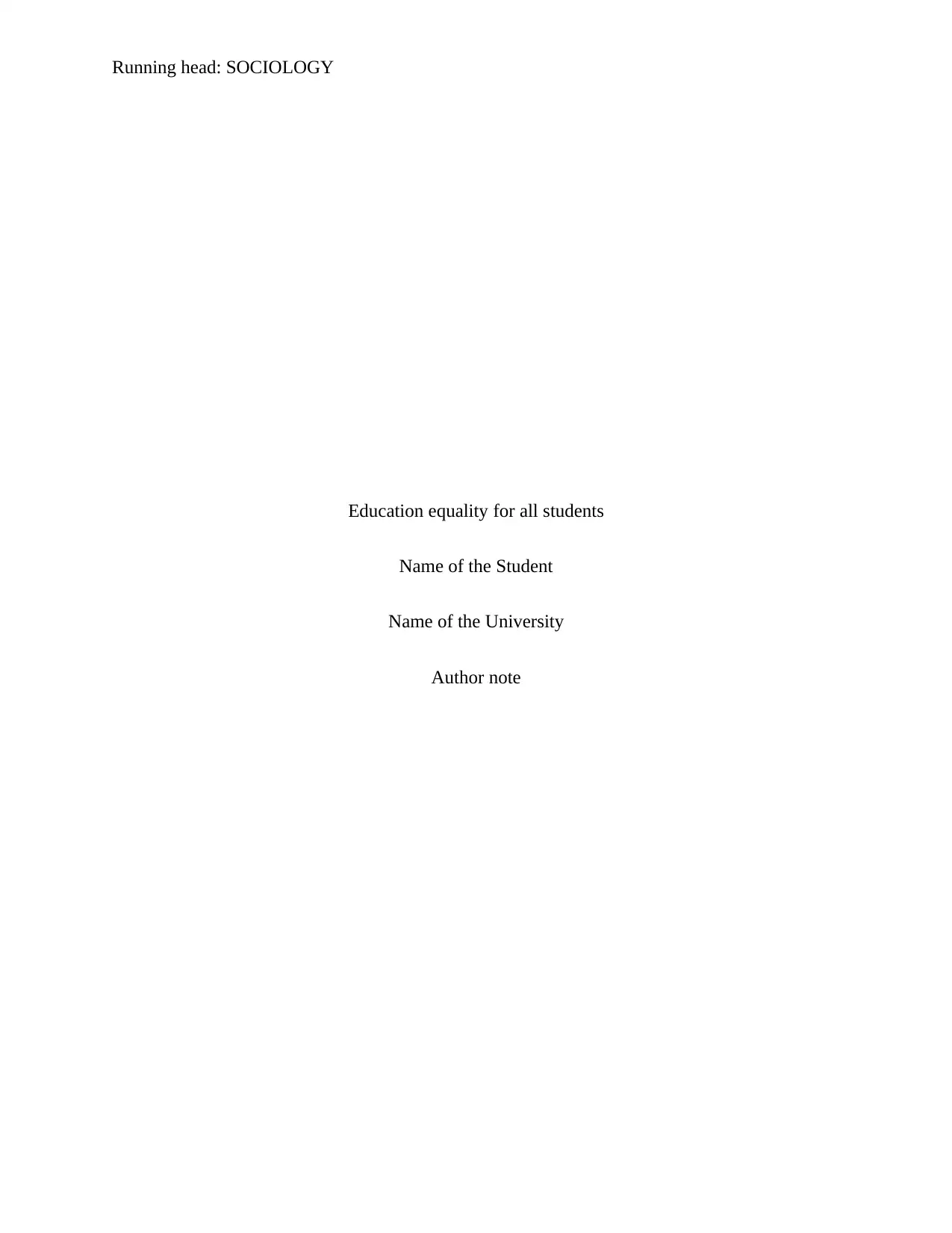
Running head: SOCIOLOGY
Education equality for all students
Name of the Student
Name of the University
Author note
Education equality for all students
Name of the Student
Name of the University
Author note
Paraphrase This Document
Need a fresh take? Get an instant paraphrase of this document with our AI Paraphraser
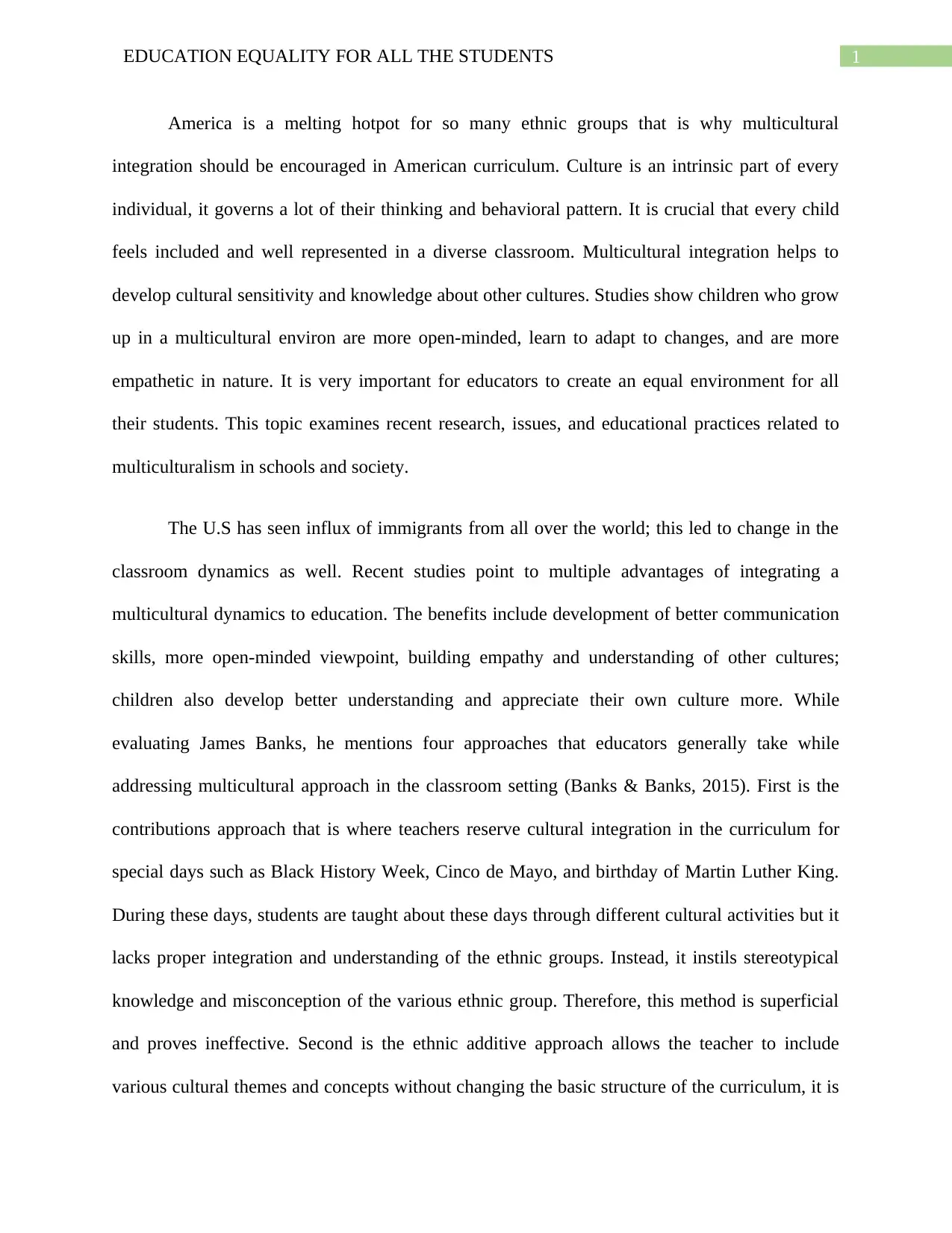
1EDUCATION EQUALITY FOR ALL THE STUDENTS
America is a melting hotpot for so many ethnic groups that is why multicultural
integration should be encouraged in American curriculum. Culture is an intrinsic part of every
individual, it governs a lot of their thinking and behavioral pattern. It is crucial that every child
feels included and well represented in a diverse classroom. Multicultural integration helps to
develop cultural sensitivity and knowledge about other cultures. Studies show children who grow
up in a multicultural environ are more open-minded, learn to adapt to changes, and are more
empathetic in nature. It is very important for educators to create an equal environment for all
their students. This topic examines recent research, issues, and educational practices related to
multiculturalism in schools and society.
The U.S has seen influx of immigrants from all over the world; this led to change in the
classroom dynamics as well. Recent studies point to multiple advantages of integrating a
multicultural dynamics to education. The benefits include development of better communication
skills, more open-minded viewpoint, building empathy and understanding of other cultures;
children also develop better understanding and appreciate their own culture more. While
evaluating James Banks, he mentions four approaches that educators generally take while
addressing multicultural approach in the classroom setting (Banks & Banks, 2015). First is the
contributions approach that is where teachers reserve cultural integration in the curriculum for
special days such as Black History Week, Cinco de Mayo, and birthday of Martin Luther King.
During these days, students are taught about these days through different cultural activities but it
lacks proper integration and understanding of the ethnic groups. Instead, it instils stereotypical
knowledge and misconception of the various ethnic group. Therefore, this method is superficial
and proves ineffective. Second is the ethnic additive approach allows the teacher to include
various cultural themes and concepts without changing the basic structure of the curriculum, it is
America is a melting hotpot for so many ethnic groups that is why multicultural
integration should be encouraged in American curriculum. Culture is an intrinsic part of every
individual, it governs a lot of their thinking and behavioral pattern. It is crucial that every child
feels included and well represented in a diverse classroom. Multicultural integration helps to
develop cultural sensitivity and knowledge about other cultures. Studies show children who grow
up in a multicultural environ are more open-minded, learn to adapt to changes, and are more
empathetic in nature. It is very important for educators to create an equal environment for all
their students. This topic examines recent research, issues, and educational practices related to
multiculturalism in schools and society.
The U.S has seen influx of immigrants from all over the world; this led to change in the
classroom dynamics as well. Recent studies point to multiple advantages of integrating a
multicultural dynamics to education. The benefits include development of better communication
skills, more open-minded viewpoint, building empathy and understanding of other cultures;
children also develop better understanding and appreciate their own culture more. While
evaluating James Banks, he mentions four approaches that educators generally take while
addressing multicultural approach in the classroom setting (Banks & Banks, 2015). First is the
contributions approach that is where teachers reserve cultural integration in the curriculum for
special days such as Black History Week, Cinco de Mayo, and birthday of Martin Luther King.
During these days, students are taught about these days through different cultural activities but it
lacks proper integration and understanding of the ethnic groups. Instead, it instils stereotypical
knowledge and misconception of the various ethnic group. Therefore, this method is superficial
and proves ineffective. Second is the ethnic additive approach allows the teacher to include
various cultural themes and concepts without changing the basic structure of the curriculum, it is
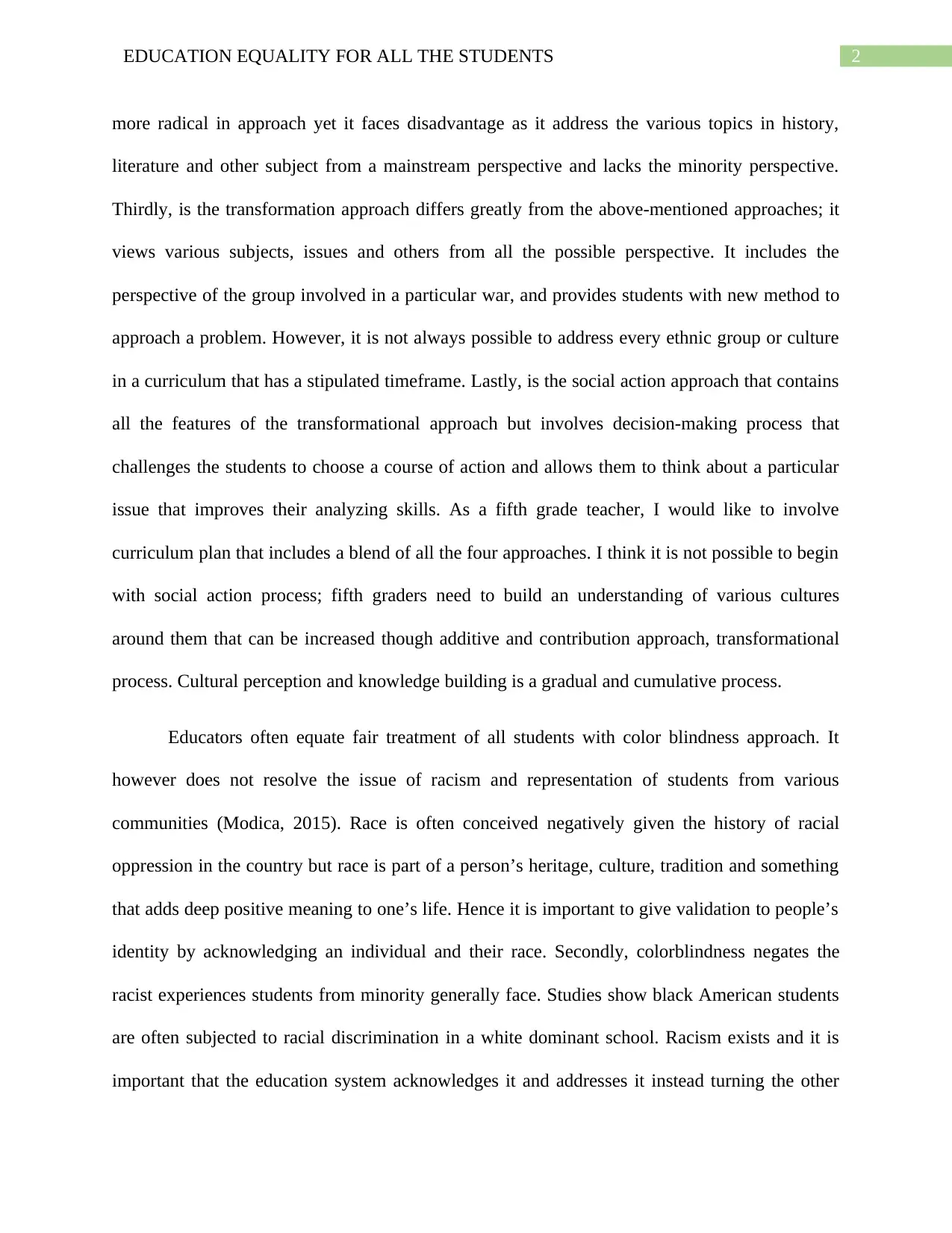
2EDUCATION EQUALITY FOR ALL THE STUDENTS
more radical in approach yet it faces disadvantage as it address the various topics in history,
literature and other subject from a mainstream perspective and lacks the minority perspective.
Thirdly, is the transformation approach differs greatly from the above-mentioned approaches; it
views various subjects, issues and others from all the possible perspective. It includes the
perspective of the group involved in a particular war, and provides students with new method to
approach a problem. However, it is not always possible to address every ethnic group or culture
in a curriculum that has a stipulated timeframe. Lastly, is the social action approach that contains
all the features of the transformational approach but involves decision-making process that
challenges the students to choose a course of action and allows them to think about a particular
issue that improves their analyzing skills. As a fifth grade teacher, I would like to involve
curriculum plan that includes a blend of all the four approaches. I think it is not possible to begin
with social action process; fifth graders need to build an understanding of various cultures
around them that can be increased though additive and contribution approach, transformational
process. Cultural perception and knowledge building is a gradual and cumulative process.
Educators often equate fair treatment of all students with color blindness approach. It
however does not resolve the issue of racism and representation of students from various
communities (Modica, 2015). Race is often conceived negatively given the history of racial
oppression in the country but race is part of a person’s heritage, culture, tradition and something
that adds deep positive meaning to one’s life. Hence it is important to give validation to people’s
identity by acknowledging an individual and their race. Secondly, colorblindness negates the
racist experiences students from minority generally face. Studies show black American students
are often subjected to racial discrimination in a white dominant school. Racism exists and it is
important that the education system acknowledges it and addresses it instead turning the other
more radical in approach yet it faces disadvantage as it address the various topics in history,
literature and other subject from a mainstream perspective and lacks the minority perspective.
Thirdly, is the transformation approach differs greatly from the above-mentioned approaches; it
views various subjects, issues and others from all the possible perspective. It includes the
perspective of the group involved in a particular war, and provides students with new method to
approach a problem. However, it is not always possible to address every ethnic group or culture
in a curriculum that has a stipulated timeframe. Lastly, is the social action approach that contains
all the features of the transformational approach but involves decision-making process that
challenges the students to choose a course of action and allows them to think about a particular
issue that improves their analyzing skills. As a fifth grade teacher, I would like to involve
curriculum plan that includes a blend of all the four approaches. I think it is not possible to begin
with social action process; fifth graders need to build an understanding of various cultures
around them that can be increased though additive and contribution approach, transformational
process. Cultural perception and knowledge building is a gradual and cumulative process.
Educators often equate fair treatment of all students with color blindness approach. It
however does not resolve the issue of racism and representation of students from various
communities (Modica, 2015). Race is often conceived negatively given the history of racial
oppression in the country but race is part of a person’s heritage, culture, tradition and something
that adds deep positive meaning to one’s life. Hence it is important to give validation to people’s
identity by acknowledging an individual and their race. Secondly, colorblindness negates the
racist experiences students from minority generally face. Studies show black American students
are often subjected to racial discrimination in a white dominant school. Racism exists and it is
important that the education system acknowledges it and addresses it instead turning the other
⊘ This is a preview!⊘
Do you want full access?
Subscribe today to unlock all pages.

Trusted by 1+ million students worldwide
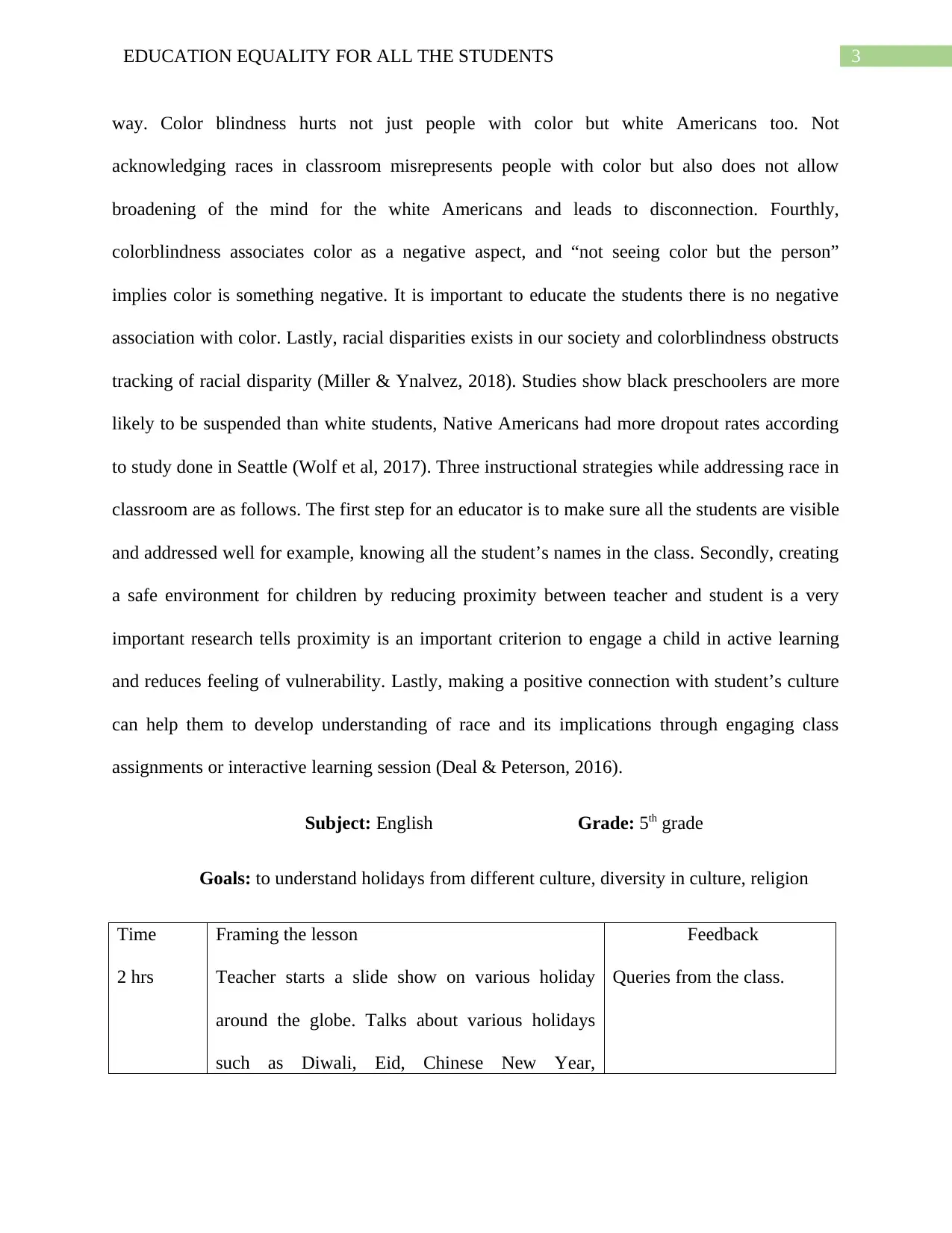
3EDUCATION EQUALITY FOR ALL THE STUDENTS
way. Color blindness hurts not just people with color but white Americans too. Not
acknowledging races in classroom misrepresents people with color but also does not allow
broadening of the mind for the white Americans and leads to disconnection. Fourthly,
colorblindness associates color as a negative aspect, and “not seeing color but the person”
implies color is something negative. It is important to educate the students there is no negative
association with color. Lastly, racial disparities exists in our society and colorblindness obstructs
tracking of racial disparity (Miller & Ynalvez, 2018). Studies show black preschoolers are more
likely to be suspended than white students, Native Americans had more dropout rates according
to study done in Seattle (Wolf et al, 2017). Three instructional strategies while addressing race in
classroom are as follows. The first step for an educator is to make sure all the students are visible
and addressed well for example, knowing all the student’s names in the class. Secondly, creating
a safe environment for children by reducing proximity between teacher and student is a very
important research tells proximity is an important criterion to engage a child in active learning
and reduces feeling of vulnerability. Lastly, making a positive connection with student’s culture
can help them to develop understanding of race and its implications through engaging class
assignments or interactive learning session (Deal & Peterson, 2016).
Subject: English Grade: 5th grade
Goals: to understand holidays from different culture, diversity in culture, religion
Time
2 hrs
Framing the lesson
Teacher starts a slide show on various holiday
around the globe. Talks about various holidays
such as Diwali, Eid, Chinese New Year,
Feedback
Queries from the class.
way. Color blindness hurts not just people with color but white Americans too. Not
acknowledging races in classroom misrepresents people with color but also does not allow
broadening of the mind for the white Americans and leads to disconnection. Fourthly,
colorblindness associates color as a negative aspect, and “not seeing color but the person”
implies color is something negative. It is important to educate the students there is no negative
association with color. Lastly, racial disparities exists in our society and colorblindness obstructs
tracking of racial disparity (Miller & Ynalvez, 2018). Studies show black preschoolers are more
likely to be suspended than white students, Native Americans had more dropout rates according
to study done in Seattle (Wolf et al, 2017). Three instructional strategies while addressing race in
classroom are as follows. The first step for an educator is to make sure all the students are visible
and addressed well for example, knowing all the student’s names in the class. Secondly, creating
a safe environment for children by reducing proximity between teacher and student is a very
important research tells proximity is an important criterion to engage a child in active learning
and reduces feeling of vulnerability. Lastly, making a positive connection with student’s culture
can help them to develop understanding of race and its implications through engaging class
assignments or interactive learning session (Deal & Peterson, 2016).
Subject: English Grade: 5th grade
Goals: to understand holidays from different culture, diversity in culture, religion
Time
2 hrs
Framing the lesson
Teacher starts a slide show on various holiday
around the globe. Talks about various holidays
such as Diwali, Eid, Chinese New Year,
Feedback
Queries from the class.
Paraphrase This Document
Need a fresh take? Get an instant paraphrase of this document with our AI Paraphraser
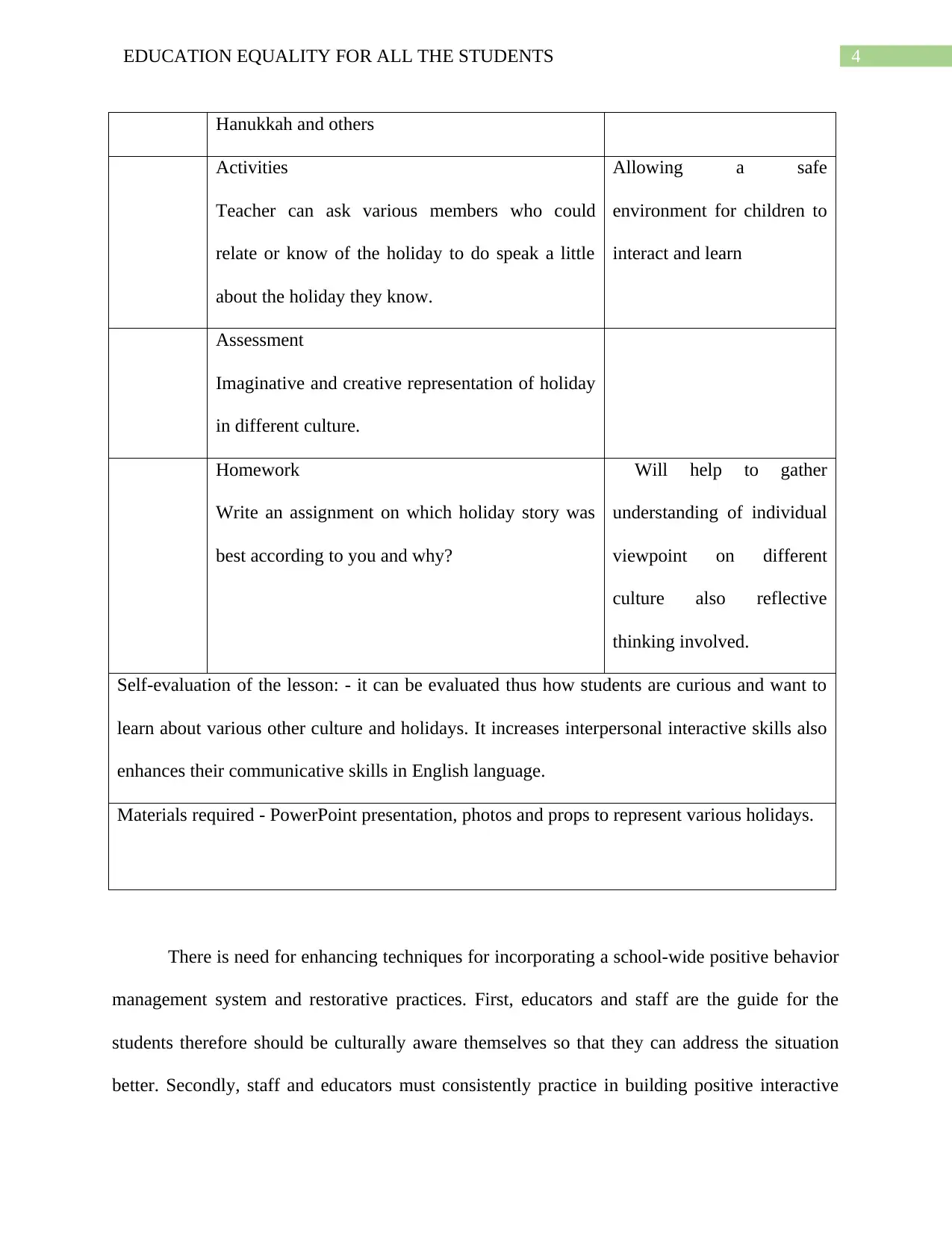
4EDUCATION EQUALITY FOR ALL THE STUDENTS
Hanukkah and others
Activities
Teacher can ask various members who could
relate or know of the holiday to do speak a little
about the holiday they know.
Allowing a safe
environment for children to
interact and learn
Assessment
Imaginative and creative representation of holiday
in different culture.
Homework
Write an assignment on which holiday story was
best according to you and why?
Will help to gather
understanding of individual
viewpoint on different
culture also reflective
thinking involved.
Self-evaluation of the lesson: - it can be evaluated thus how students are curious and want to
learn about various other culture and holidays. It increases interpersonal interactive skills also
enhances their communicative skills in English language.
Materials required - PowerPoint presentation, photos and props to represent various holidays.
There is need for enhancing techniques for incorporating a school-wide positive behavior
management system and restorative practices. First, educators and staff are the guide for the
students therefore should be culturally aware themselves so that they can address the situation
better. Secondly, staff and educators must consistently practice in building positive interactive
Hanukkah and others
Activities
Teacher can ask various members who could
relate or know of the holiday to do speak a little
about the holiday they know.
Allowing a safe
environment for children to
interact and learn
Assessment
Imaginative and creative representation of holiday
in different culture.
Homework
Write an assignment on which holiday story was
best according to you and why?
Will help to gather
understanding of individual
viewpoint on different
culture also reflective
thinking involved.
Self-evaluation of the lesson: - it can be evaluated thus how students are curious and want to
learn about various other culture and holidays. It increases interpersonal interactive skills also
enhances their communicative skills in English language.
Materials required - PowerPoint presentation, photos and props to represent various holidays.
There is need for enhancing techniques for incorporating a school-wide positive behavior
management system and restorative practices. First, educators and staff are the guide for the
students therefore should be culturally aware themselves so that they can address the situation
better. Secondly, staff and educators must consistently practice in building positive interactive
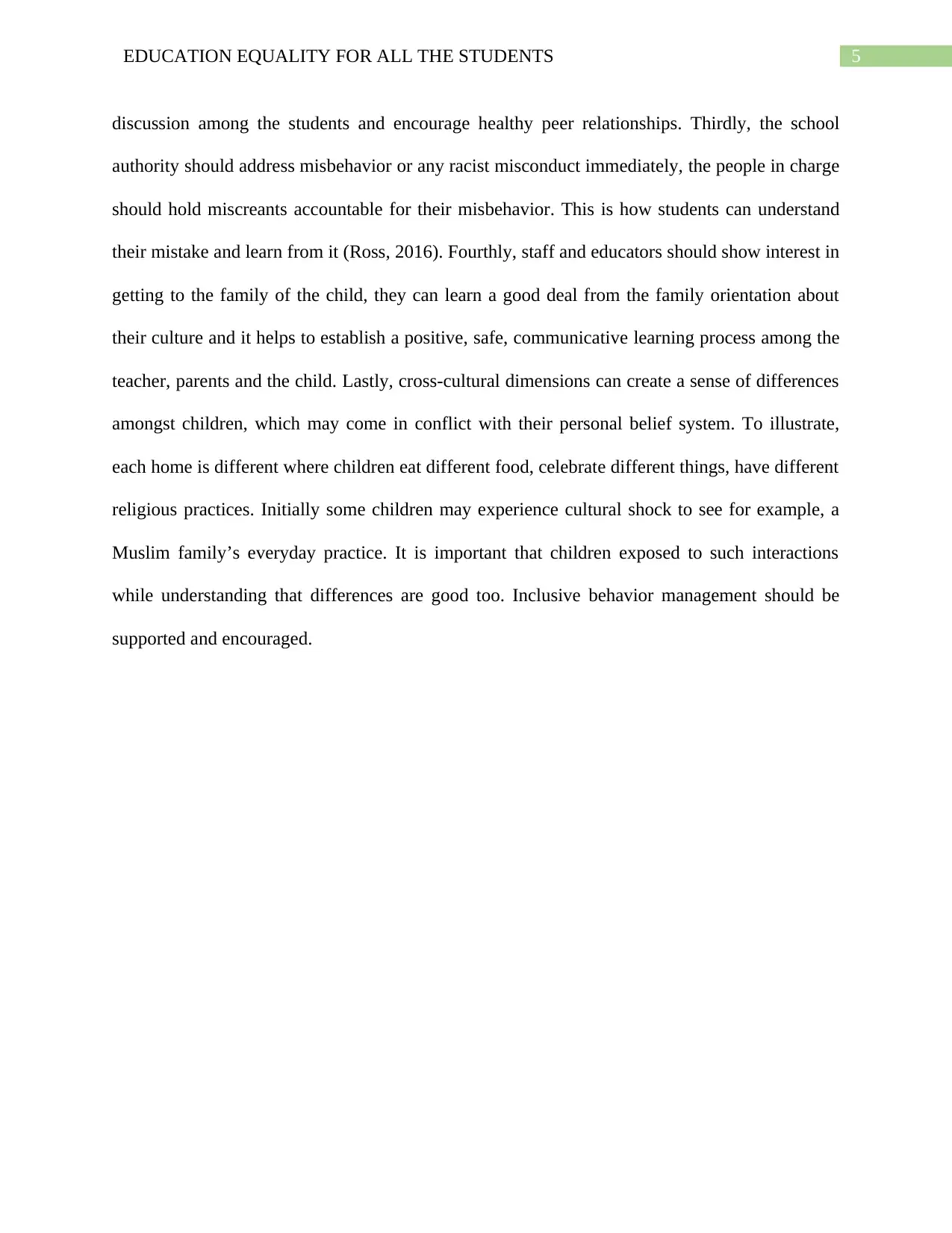
5EDUCATION EQUALITY FOR ALL THE STUDENTS
discussion among the students and encourage healthy peer relationships. Thirdly, the school
authority should address misbehavior or any racist misconduct immediately, the people in charge
should hold miscreants accountable for their misbehavior. This is how students can understand
their mistake and learn from it (Ross, 2016). Fourthly, staff and educators should show interest in
getting to the family of the child, they can learn a good deal from the family orientation about
their culture and it helps to establish a positive, safe, communicative learning process among the
teacher, parents and the child. Lastly, cross-cultural dimensions can create a sense of differences
amongst children, which may come in conflict with their personal belief system. To illustrate,
each home is different where children eat different food, celebrate different things, have different
religious practices. Initially some children may experience cultural shock to see for example, a
Muslim family’s everyday practice. It is important that children exposed to such interactions
while understanding that differences are good too. Inclusive behavior management should be
supported and encouraged.
discussion among the students and encourage healthy peer relationships. Thirdly, the school
authority should address misbehavior or any racist misconduct immediately, the people in charge
should hold miscreants accountable for their misbehavior. This is how students can understand
their mistake and learn from it (Ross, 2016). Fourthly, staff and educators should show interest in
getting to the family of the child, they can learn a good deal from the family orientation about
their culture and it helps to establish a positive, safe, communicative learning process among the
teacher, parents and the child. Lastly, cross-cultural dimensions can create a sense of differences
amongst children, which may come in conflict with their personal belief system. To illustrate,
each home is different where children eat different food, celebrate different things, have different
religious practices. Initially some children may experience cultural shock to see for example, a
Muslim family’s everyday practice. It is important that children exposed to such interactions
while understanding that differences are good too. Inclusive behavior management should be
supported and encouraged.
⊘ This is a preview!⊘
Do you want full access?
Subscribe today to unlock all pages.

Trusted by 1+ million students worldwide

6EDUCATION EQUALITY FOR ALL THE STUDENTS
Reference
Banks, J. A., & Banks, C. A. M. (2015). Multicultural education.
Deal, T. E., & Peterson, K. D. (2016). Shaping school culture. John Wiley & Sons.
Miller, A. J., & Ynalvez, R. A. (2018). Meeting the Challenges of Minorities in Higher
Education: A Review of the Underrepresentation of Hispanics in Medical School. The
FASEB Journal, 32(1_supplement), 535-10.
Modica, M. (2015). Unpacking the ‘colorblind approach’: accusations of racism at a friendly,
mixed-race school. Race Ethnicity and Education, 18(3), 396-418.
Ross, K. M., Nasir, N. I. S., Givens, J. R., de Royston, M. M., Vakil, S., Madkins, T. C., &
Philoxene, D. (2016). “I do this for all of the reasons America doesn't want me to”: The
organic pedagogies of Black male instructors. Equity & Excellence in Education, 49(1),
85-99.
Wolf, P. S., David, A., Butler-Barnes, S. T., & Zile-Tamsen, V. (2017). American
Indian/Alaskan Native college dropout: Recommendations for increasing retention and
graduation. Journal on Race, Inequality, and Social Mobility in America, 1(1), 1.
Reference
Banks, J. A., & Banks, C. A. M. (2015). Multicultural education.
Deal, T. E., & Peterson, K. D. (2016). Shaping school culture. John Wiley & Sons.
Miller, A. J., & Ynalvez, R. A. (2018). Meeting the Challenges of Minorities in Higher
Education: A Review of the Underrepresentation of Hispanics in Medical School. The
FASEB Journal, 32(1_supplement), 535-10.
Modica, M. (2015). Unpacking the ‘colorblind approach’: accusations of racism at a friendly,
mixed-race school. Race Ethnicity and Education, 18(3), 396-418.
Ross, K. M., Nasir, N. I. S., Givens, J. R., de Royston, M. M., Vakil, S., Madkins, T. C., &
Philoxene, D. (2016). “I do this for all of the reasons America doesn't want me to”: The
organic pedagogies of Black male instructors. Equity & Excellence in Education, 49(1),
85-99.
Wolf, P. S., David, A., Butler-Barnes, S. T., & Zile-Tamsen, V. (2017). American
Indian/Alaskan Native college dropout: Recommendations for increasing retention and
graduation. Journal on Race, Inequality, and Social Mobility in America, 1(1), 1.
1 out of 7
Related Documents
Your All-in-One AI-Powered Toolkit for Academic Success.
+13062052269
info@desklib.com
Available 24*7 on WhatsApp / Email
![[object Object]](/_next/static/media/star-bottom.7253800d.svg)
Unlock your academic potential
Copyright © 2020–2025 A2Z Services. All Rights Reserved. Developed and managed by ZUCOL.





